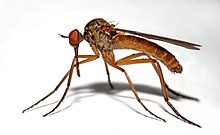Dance flying
| Dance flying | ||||||||||||
|---|---|---|---|---|---|---|---|---|---|---|---|---|

Diced dance fly ( Empis tesselata ) |
||||||||||||
| Systematics | ||||||||||||
|
||||||||||||
| Scientific name | ||||||||||||
| Empididae | ||||||||||||
| Latreille , 1804 | ||||||||||||
| Subfamilies | ||||||||||||
|
The dance flies (Empididae) are a family of the two-winged (Diptera) and are assigned to the flies (Brachycera). Around 2500 species of this group are known worldwide, in Germany around 260. The humpback dance flies (Hybotidae), which were formerly part of this family, are now a family of their own and the small dance flies (Microphorinae) are a subfamily of the long-legged flies .
Characteristics of dance flies
The mostly very small flies are often nondescript brown in color. The head is round, the males very often have greatly enlarged complex eyes . The proboscis is noticeably long in some species and is used to pierce and suckle the prey. The legs of the flies are relatively long, with a pair of legs often formed into a muzzle with a thorny thigh ( femur ) and a curved lower leg ( tibia ), for example in the representatives of the genus Chelifera .
Way of life of the dance flies
The dance flies feed primarily on other insects, which they usually grab and sting in flight. Insects that are significantly larger than flies are very often attacked, and cannibalism also occurs. However, the representatives of the subfamily Empidinae have evolved into flower visitors who only consume animal food as larvae and when mating. The highly elongated mouthparts of the genera Empis and Rhamphomyia developed in line with the proboscis .
Reproductive behavior

The reproductive behavior of dance flies has been very well researched. With many species of this group, smaller swarms form in advance, which are called "dance groups" and are responsible for the naming. The individuals in these groups fly in quick zigzags and turns, with the wind playing a major role. The dance groups always consist entirely of either males or females and are flown to by representatives of the opposite sex. These dance groups are best known among the Empis , Rhamphomyia and Hilara species.
The male approaches a female mostly from below. In some species, the two partners rub each other's feet ( tarsi ). Also common is the behavior in which the male hands the female a gift of prey, which the female suckles during mating. This behavior can also be observed in the actually vegetarian Empidinae. With some Hilara species, the gift is wrapped in spider threads that are made with the spinneret in the widened first phalanx. Males of Empis opaca were seen taking the gift back with them after mating and handing it over to another female. In these cases the gift obviously stimulates pairing. It is accepted by the females but not used, sometimes only part of the plant wrapped with spider threads is handed over. The actual copulation takes place either sitting or hanging.
The male of Hilara sartor holds a thread veil with his legs while dancing, which obviously attracts females as a visual signal. The male is flown under by the female and falls on top of it, the mating takes place in flight while the veil falls.
Development of the larvae
The larvae of the dancing flies feed on various smaller insects. The trachea used for breathing are amphipneus , so only open at the front and back. The larvae sometimes live in water or in trickled soil, but mostly in the ground. The pupation also takes place in the ground.
Internal system
The systematics of the Empidoidea and thus also of the dance flies is the subject of current research. There are still a number of genera whose position has not yet been clarified. The following is a systematic.
| Empididae |
|
||||||||||||||||||||||||||||||||||||||||||||||||||||||||||||||||||||||||||||||||||||||||||||||||||||||||||||||||||||||||||||||||||||||||||||||||||||||||||||||||||||||||||||||||||||||||||||||||||||||||||||||||||||||||||||||||||||
|
|
Fossil evidence
The fossil family is mainly known from amber . There are isolated finds from Cretaceous and Tertiary sediments from Central Asia, England, Alaska and Japan .
The oldest fossil dance flies come from amber from the Lower Cretaceous Lebanon (approx. 130 million years old). Dancing flies have been found in other Cretaceous and Tertiary amber deposits, but the family is relatively rich in species and individuals only in the Eocene Baltic amber .
Selected species
- Bright dance fly Empis livida
- Empis opaca
- Red-brown dance fly Empis stercorea
- Diced dance fly Empis tesselata
- Hilara sartor
- Rhamphomyia marginata
- Xanthempis digramma
Individual evidence
- ↑ Bradley J. Sinclair & Jeffrey M. Cumming: The morphology, higher-level phylogeny and classification of the Empidoidea (Diptera) 2006
- ↑ Family Empididae. on: hbs.bishopmuseum.org
- ↑ George O. Poinar, Jr .: Life in Amber. Stanford University Press, Stanford (Cal.) 1992, ISBN 0-8047-2001-0 .
- ↑ Wolfgang Weitschat, Wilfried Wichard: Atlas of plants and animals in the Baltic amber. Pfeil-Verlag, Munich 1998, ISBN 3-931516-45-8 .
literature
- M. Chvála: Swarming, mating and feeding habits in Empididae (Diptera), and their significance in evolution of the family. In: Aca Ent Bohem. 73, 1976, pp. 353-366.
- M. Chvála: The Empidoidea (Diptera) of Fennscandia and Denmark. Part II. In: Faun. Ent. Scand. 12, 1983, pp. 1-275.
- JE Collin: British Flies. Volume VI: Empididae. Cambridge 1961.
- J. Haupt, H. Haupt: Flies and mosquitoes - observation, way of life. Augsburg 1998.
- K. Honomichl, H. Bellmann: Biology and ecology of the insects. CD-ROM. Gustav Fischer Verlag, Stuttgart 1994.


